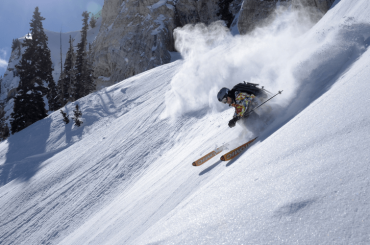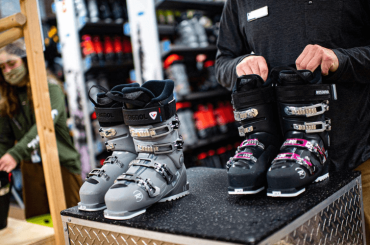If you’re wondering if you can ski after a hip replacement, the short answer is yes, you can. However, there are some things to keep in mind before hitting the slopes.
In this blog post, we’ll discuss the basics of skiing after a hip replacement and offer some advice on how to stay safe while enjoying this winter activity.
Can you ski after a hip replacement/cross-country skiing after a hip replacement?
If you have a hip replacement, you may be wondering if you can still ski or do other activities that put stress on your hip joint. The good news is that skiing is generally safe after a hip replacement. However, there are some things to keep in mind before hitting the slopes.
- First, check with your doctor to make sure skiing is safe for you. You may need to take some precautions, such as wearing a brace, but generally speaking, skiing is safe after a hip replacement.
- Second, cross-country skiing may be a bit more challenging after a hip replacement.
- This is because it requires more range of motion in the hip joint. However, it is still possible to cross-country ski after a hip replacement.
- Finally, keep in mind that skiing and cross-country skiing are both excellent exercises for strengthening the muscles around your hip joint. This can help prevent future problems.
So even though it may be a bit tricky at first, don’t give up – you’ll be back on the slopes in no time!
What is a hip replacement and what are the risks associated with it?
A hip replacement is a surgery to replace the hip joint with an artificial one. It is usually done when the hip joint is damaged beyond repair. The most common reason for this surgery is to relieve pain and disability from arthritis or other conditions that damage the hip joint.
The risks associated with a hip replacement include infection, bleeding, blood clots and nerve damage. There is also a small risk that the implant will not fuse properly to the bone, or that it will loosen or break.
These complications can usually be treated with revision surgery. In rare cases, more serious complications can occur, such as joint instability or dislocation. If you are considering a hip replacement, be sure to discuss all of the risks and potential complications with your surgeon.
How skiing can affect someone who has had a hip replacement?
Skiing can have several different effects on someone who has had a hip replacement, depending on the individual’s level of activity and the type of skiing they are doing. For example, alpine skiing (downhill skiing) can be more strenuous on the hip than cross-country skiing.
Additionally, people who are more active in general may have more difficulty with their hip after surgery than those who are less active. Some common issues that can arise include pain, swelling and stiffness in the hip joint.
In some cases, these problems can lead to instability in the joint and an increased risk of dislocation. It is important to discuss any concerns with your doctor before engaging in any type of skiing after a hip replacement.
Tips for skiing after a hip replacement?
- First and foremost, consult with your doctor before hitting the slopes after a hip replacement. Once you have the all-clear, there are some things you can do to make skiing easier and safer.
- Wear a brace or support device if recommended by your doctor. This will help stabilize your new hip and prevent it from dislocating.
- Start slow and take it easy at first. Avoid mogul skiing and other difficult terrain. Instead, stick to groomed trails and beginner slopes. Work your way up as you build strength and confidence.
- Be extra careful when getting in and out of ski lifts. Ask for help if needed. Use caution when sitting down on chairlifts – don’t let your skis slide out from under you. Wear layers of apparel to remain warm and dry. This will also help prevent muscle strains.
- Stay hydrated by drinking plenty of water and avoid alcohol, which can dehydrate you and affect your balance. Enjoy regular reprieves to rest and stretch your muscles. This will help you avoid fatigue and injury.
- Listen to your body – if something doesn’t feel right, stop skiing and seek medical attention if necessary.
Following these tips can help you safely enjoy skiing after a hip replacement. However, it’s important to listen to your body and heed any pain or discomfort you may feel. If in doubt, consult with your doctor before hitting the slopes.
The benefits of skiing after a hip replacement?
- Improve your range of motion and flexibility.
- Skiing can help strengthen muscles around your hip.
- A great way to get some aerobic exercise.
- Skiing can be a fun activity with family and friends.
- However, it is important to understand the risks involved in skiing after a hip replacement and to make sure you are healthy enough to ski. Talk to your doctor about the risks and benefits before hitting the slopes.
Ski resorts that are best for those who have had a hip replacement?
There are a few things to consider when looking for the best ski resorts for those who have had a hip replacement.
- The first is the size of the resort. A smaller resort may be easier to navigate and the lifts may be less crowded.
- The second is the terrain. Some resorts have more beginner-friendly terrain than others.
- Finally, it is important to consider the ski school options at each resort. Many ski schools now offer adaptive programs that can help skiers with special needs.
Below are five great ski resorts for those who have had a hip replacement.
- Beaver Creek Resort in Colorado
- Jackson Hole Mountain Resort in Wyoming
- Park City Mountain Resort in Utah
- Squaw Valley Alpine Meadows in California
- Whistler Blackcomb in British Columbia, Canada
These ski resorts offer wide groomed trails, plenty of uphill terrain and great amenities.
How to stay safe while skiing after a hip replacement?
If you’ve had a hip replacement, skiing can still be a fun and safe activity for you. However, it’s important to take some extra precautions to make sure you don’t injure your new hip. Here are a few tips:
- Talk to your doctor before hitting the slopes. Make sure they approve of your plan and don’t have any concerns.
- Start slow. Don’t try to ski as aggressively as you did before your surgery. Ease into it and build up your strength and stamina over time.
- Be aware of your surroundings. Skiing can be dangerous even if you’re in perfect health, so always be on the lookout for obstacles or other skiers.
- Take breaks often. Don’t push yourself too hard. If you need to take a break, sit down on the snow and rest. Wear the right gear. Make sure you have all the proper safety equipment, including a helmet, knee pads and elbow pads.
Follow the rules. Obey all signs and post warnings on the slopes. Listen to your body. If something doesn’t feel right, or you’re in pain, stop skiing and seek help.
Skiing is a great way to stay active after a hip replacement, but it’s important to be safe about it. Talk to your doctor before hitting the slopes, start slow and be aware of your surroundings at all times.
Wearing the proper safety gear is also essential. If you follow these tips, you can enjoy skiing for many years to come.
Did You Know: When does ski season start in Colorado?
FAQs – ski after a hip replacement
Can you ski if you have arthritis?
While there is no definitive answer, as it depends on the individual case. Some people with arthritis may find that they can ski without any problems, while others may find that their condition makes it more difficult or even impossible to ski.
In general, however, it is generally advisable for people with arthritis to consult with their doctor.
What activities are prohibited after hip replacement?
There are a few activities that are generally prohibited after hip replacement surgery. These include:
- Hinging at the hip past 90 degrees, such as when trying to tie your shoes.
- Bending the hip too far back, such as when doing a sit-up
- Crossing your legs at the knees.
- Putting all your weight on the operated leg, such as when standing up from a chair.
Your doctor or physical therapist will give you specific instructions on what activities to avoid after your surgery. It is important to follow these instructions to help ensure a successful recovery.
What are lifelong restrictions after hip replacement?
There are a few lifelong restrictions that you will need to follow after having hip replacement surgery. These include:
- Keeping away from high-influence activities, such as running or jogging.
- Avoid activities that require you to bend your hip too far back, such as sit-ups.
- Not folding your legs at the knees.
- Wear shoes that fit properly and support your feet.
- Circling back to your PCP for customary check-ups.
These restrictions are in place to help protect your new hip and ensure a successful recovery. If you have any questions or concerns, be sure to talk to your doctor.
What is the success rate of hip replacement surgery?
The success rate of hip replacement surgery is extremely high, with most people experiencing a significant improvement in their quality of life after the procedure.
In general, the success rate of hip replacement surgery is about 95%. This means that out of every 100 people who have the surgery, 95 will experience a successful outcome.
What sports should be avoided after hip replacement?
There are a few sports that should be avoided after hip replacement surgery. These include:
- Running or jogging
- High-impact aerobics
- Tennis
- Basketball
These activities are generally prohibited because they put too much stress on the new hip. If you have any questions or concerns, be sure to talk to your doctor.
How long does it take for hip replacement to heal completely?
It typically takes about 3-6 months for the incision to heal completely and for the new hip to fully recover.
However, some people may experience a longer recovery time. It is important to follow your doctor’s instructions and to take things slowly to ensure a successful outcome.
Conclusion:
skiing after a hip replacement is generally safe. However, you should always check with your doctor before skiing or engaging in any other strenuous activity.
Cross-country skiing may be a good option for those who want to ski but are concerned about the impact that downhill skiing might have on their hips. As always, safety is the most important consideration when engaging in any physical activity.





